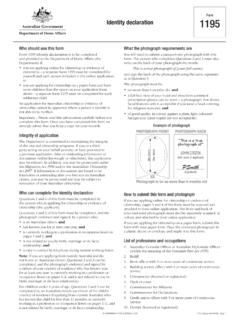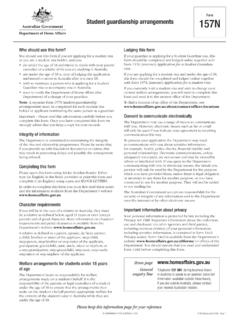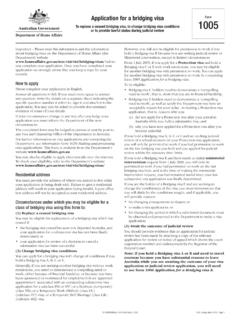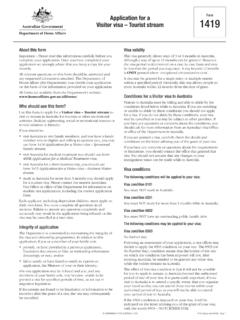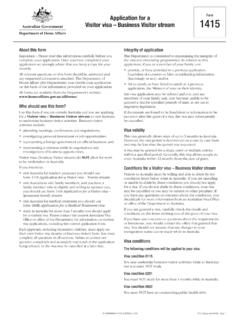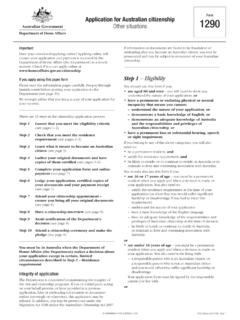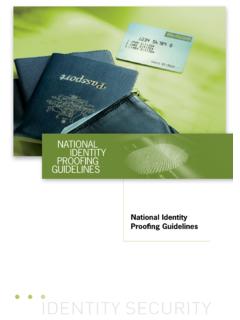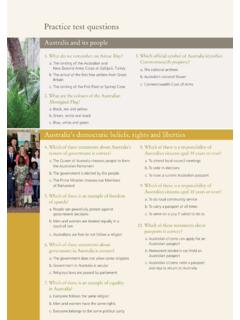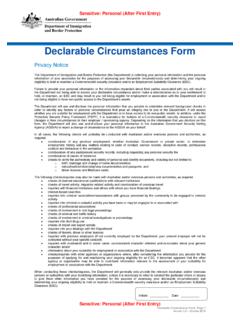Transcription of Protecting Critical Infrastructure and Systems of National ...
1 OFFICIAL. Protecting Critical Infrastructure and Systems of National Significance Draft Critical Infrastructure Asset Definition Rules April 2021. 1300 27 25 24. OFFICIAL. OFFICIAL. Contents Contents 2. Background 4. Communications sector 6. Critical broadcasting assets 6. Critical domain name Systems 7. Energy sector 8. Critical electricity assets 8. Critical gas assets 9. Critical liquid fuel assets 10. Liquid fuel refineries 10. Liquid fuel pipelines 10. Liquid fuel storage facilities 11. Financial services and markets sector 13. Critical banking assets 13. Critical financial market Infrastructure assets 14. Financial markets 14. Clearing and settlement facilities 15. Significant financial benchmarks 16. Derivative trade repositories 17. Payment Systems 18. Critical insurance assets 19. Insurance businesses 19. Life insurance businesses 20. Health insurance businesses 21.
2 Critical superannuation assets 22. Food and grocery sector 23. Critical food and grocery assets 23. Higher education and research sector 25. Critical Education Asset 25. Transport sector 26. Critical freight Infrastructure assets 26. Critical freight services assets 28. Attachment A Critical Infrastructure assets that do not require threshold definition rules 30. Communications sector 30. Protecting Critical Infrastructure and Critical Infrastructure Centre OFFICIAL Systems of National Significance | 2. OFFICIAL. Critical Telecommunications Asset 30. Data storage and processing sector 30. Critical Data Storage or Processing Asset 30. Defence Sector 31. Critical Defence Industry Asset 31. Energy Sector 31. Critical energy market operator asset 32. Health sector 32. Critical Hospital Asset 32. Transport sector 32. Critical Aviation Assets 32. Critical Port Asset 33.
3 Critical Public Transport Asset 33. Water and sewerage sector 34. Critical Water and Sewerage Assets 34. Attachment B Intermodal Terminals 35. Protecting Critical Infrastructure and Critical Infrastructure Centre OFFICIAL Systems of National Significance | 3. OFFICIAL. Background The security of Critical Infrastructure Act 2018 (the Act) currently seeks to manage the complex and evolving National security risks of sabotage, espionage and coercion posed by foreign involvement in Australia's Critical Infrastructure . The Act currently applies to approximately 200 assets in the electricity, gas, water and ports sectors. The Australian Government is committed to Protecting the essential services all Australia ns rely on by uplifting the security and resilience of our Critical Infrastructure . As the threats and risks to Australia's Critical Infrastructure evolve in a post-COVID world, so too must our approach to ensuring the ongoing security and resilience of th ese assets and the essential services they deliver.
4 security Legislation Amendment ( Critical Infrastructure ). Bill 2020. The security Legislation Amendment ( Critical Infrastructure ) Bill 2020 (the Bill) , introduced into Parliament on 10 December 2020, amends and builds on the existing regulatory regime created by the Act. The Bill introduces an enhanced regulatory framework for 11 identified industry sectors by amending the Act to: establish additional positive security obligations for Critical Infrastructure assets (comprising of adopting and maintaining an all-hazards Critical Infrastructure risk management program, mandatory reporting of serious cyber security incidents, and where required, providing ownership and operational information to the Regis ter of Critical Infrastructure Assets);. introduce enhanced cyber security obligations for those Critical Infrastructure assets most important to the nation, described as Systems of National significance; and provide Government assistance to relevant entities for Critical Infrastructure sector assets in response to significant serious cyber security incidents that impact on Australia's Critical Infrastructure assets.
5 The Bill also expands the definition of Critical Infrastructure assets in the Act to a total of 22. Critical Infrastructure asset classes which will be subject to the enhanced regulatory framework upon passage of the Bill. These requirements apply to both foreign-owned and Australian-owned Critical Infrastructure where the Critical Infrastructure asset is located in Australia. Protecting Critical Infrastructure and Critical Infrastructure Centre OFFICIAL Systems of National Significance | 4. OFFICIAL. Under the Bill, 12 of the identified 22 asset classes require further rules to be made to finalise the assets subject to the enhanced regulatory framework. These 12 asset classes are: Critical banking assets Critical freight Infrastructure assets Critical broadcasting assets Critical freight services assets Critical domain name Systems Critical gas assets Critical electricity assets Critical insurance assets Critical financial market Infrastructure Critical liquid fuel assets assets Critical superannuation assets Critical food and grocery assets The proposed rules for these 12 asset classes have been prepared in consultation with Commonwealth, State and Territory Government partners.
6 Building on industry engagement during the development of the Bill, the Department seeks to ensure that the Critical Infrastructure assets captured are those services that are vital to Australia's security , economic prosperity and way of life while minimising regulatory impost on industry. The purpose of this paper is to seek public feedback on these proposed rules, noting that rules are made by, and subject to the approval of, the Minister for Home Affairs. Please provide any feedback on the proposed thresholds by 14 May 2021 to The remaining 10 asset classes defined in the Bill that do not require further rules to be made are outlined in Attachment A. Protecting Critical Infrastructure and Critical Infrastructure Centre OFFICIAL Systems of National Significance | 5. OFFICIAL. Communications sector Critical broadcasting assets Section 12E of the Bill provides that: (1) One or more broadcasting transmission assets are a Critical broadcasting asset if: (a) the broadcasting transmission assets are: (i) owned or operated by the same entity; and (ii) located on a site that, in accordance with subsection (2), is a Critical transmission site; or (b) the broadcasting transmission assets are: (i) owned or operated by the same entity; and (ii) located on at least 50 different sites; and (iii) not broadcasting re-transmission assets; or (c) the broadcasting transmission assets are owned or operated by an entity that, in accordance with subsection (3), is Critical to the transmission of a broadcasting service.
7 (2) For the purposes of paragraph (1)(a), the rules may prescribe: (a) specified sites that are Critical transmission sites; or (b) requirements for sites to be Critical transmission sites. (3) For the purposes of paragraph (1)(c), the rules may prescribe: (a) specified entities that are Critical to the transmission of a broadcasting service; or (b) requirements for an entity to be Critical to the transmission of a broadcasting service. What we propose We intend to recommend that the Minister make rules to prescribe assets that are owned or operated by TX Australia to be Critical broadcasting assets, as TX Australia services a variety of major broadcasters, which otherwise do not meet the at least 50 sites' threshold under section 12E(b)(ii) of the Bill. Note that this is alongside the assets captured under section 12E of the Bill, which include broadcasting providers that own or operate at least 50 sites.
8 Rationale TX Australia is proposed to be specified in the rules because it owns, operates, manages, engineers, maintains and markets transmission facilities in the five major mainland metropolitan cities of Australia. TX Australia provides television transmission for broadcasters, including for commercial metropolitan television networks Seven, Nine and Ten. TX Australia is not expected to be captured by the at least 50 sites'. threshold. Severe compromise of some major broadcast transmission operators that are otherwise not captured has the potential for severe and lasting economic and security impacts, given the lack of redundancy in the sector and high volume of users. Broadcast media play an important role in emergencies and National communication Protecting Critical Infrastructure and Critical Infrastructure Centre OFFICIAL Systems of National Significance | 6.
9 OFFICIAL. campaigns, both in disseminating and collecting information. TX Australia is a major broadcast transmission operator and would play a significant role in this circumstance. It is expected that BAI Communications will be captured by the at least 50 sites'. threshold. The Department understands that: TX Australia provides digital television, digital radio & FM Radio transmission for Seven West Media and Nine Entertainment. BAI Communications is appointed to operate and maintain the broadcast network for the ABC, SBS, Network 10, Southern Cross Austereo and the NSW Public Safety Network. WIN Corporation operates and maintains the broadcasting network for Network 10, Nine Entertainment and Seven West Media in regional areas and certain parts of Australia. Critical domain name Systems Section 12KA of the Bill provides that: (1) An asset is a Critical domain name system if it: (a) is managed by an entity, that in accordance with subsection (2), is Critical to the administration of an Australian domain name system ; and (b) is used in connection with the administration of an Australian domain name system .
10 (2) For the purposes of paragraph (1)(a), the rules may prescribe: (a) specified entities that are Critical to the administration of an Australian domain name system ; or (b) requirements for an entity to be Critical to the administration of an Australian domain name system . What we propose We intend to recommend that the Minister make rules to prescribe that .au country code Top Level Domain (ccTLD) is a Critical domain name system . Rationale The .au' is Australia's country code domain. The .au namespace plays an important role in supporting the digital economy with over million domain names registered as at August 2020. Therefore, we intend to use rules to specify that .au ccTLD is a Critical domain name system . With the online environment becoming increasingly enmeshed with everyday life, a disruption to a Critical domain name system could have significant cascading implications for Australian businesses, government and the community.
